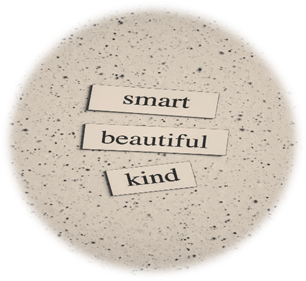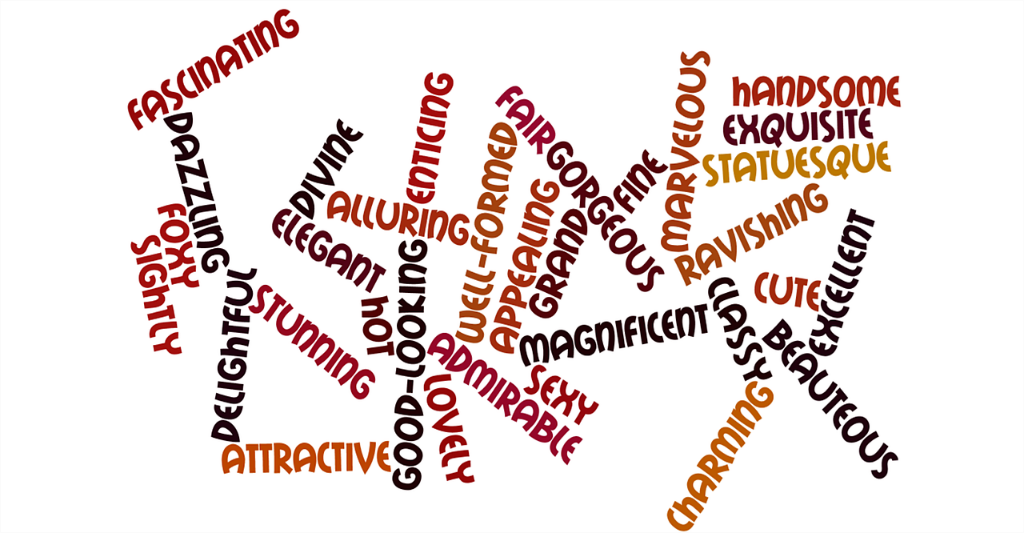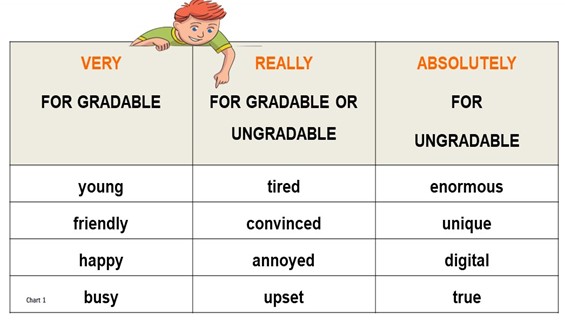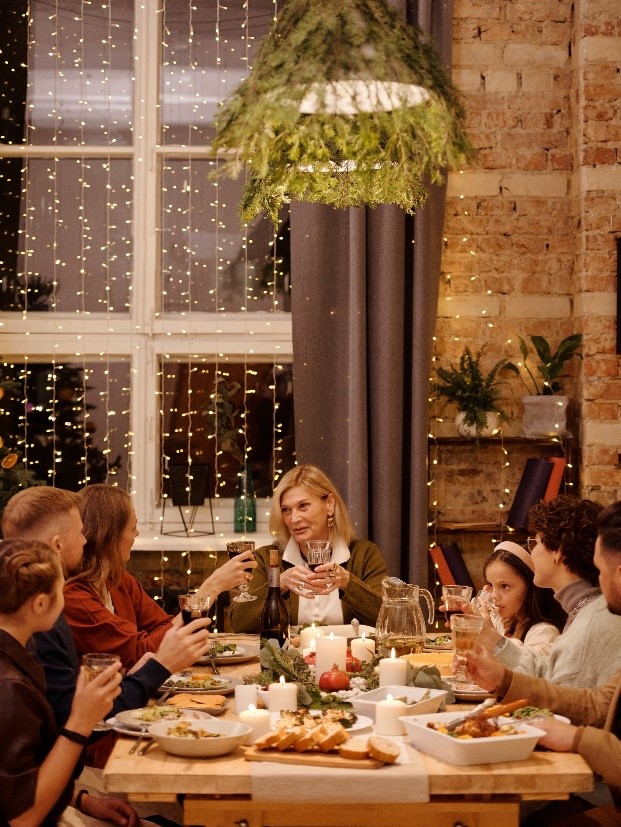I. WHAT ARE ADJECTIVES?

They are words that describe nouns or pronouns. They add information to nouns or to a noun phrase. For example:
The sky was clear blue.
Noun: sky
Adjectives: clear blue
Even though adjectives can be used in many ways, there are two common patterns for you to have in mind:
1.1. The adjective comes BEFORE the noun_ [Adj + noun] for example:
A reliable colleague/ an expensive watch/ a leather vest/ an Italian leather jacket/
Allison gave me an expensive Italian leather jacket.
1. 2. Adjectives come AFTER a noun. This happens when we use LINKING VERBS such as be, seem, grow, look, remain, smell, sound, taste, turn, become, feel, appear [Noun + linking verb +adjective]
● She is adorable.
● We feel happy for you.
● Gabe grew angry while Andie remained calm.
● My pets seem quiet today.
● Mr. Lee appeared to be upset but his wife seemed to be convinced.
● This soup smells !
II. RECOGNIZING ADJECTIVES IN THEORY

It is easy to recognize adjectives. First of all, they describe people, animals, objects, places (all kinds of nouns, pronouns and noun phrases) and follow the former patterns. However, they do not look similar to each other.
- They can have many different endings. They can end with -ed. For example: surprised, tired, convinced, worried, amused, frightened, annoyed, bored, disappointed, etc.,.They can also end with -ing. For example: surprising, tiring, convincing, worrying, amusing, frightening, annoying, etc.,
Some adjectives are compound. They are made up of two or more other words. These are very common, such as 10-year-old girl, ten-minute talk, five-page document, 500-word summary, world-famous tennis player, fat-free snacks, cutting-edge technology, two-week break, record-breaking snow, Kingdom of Heaven actress, freelance work, beautifully painted portrait, etcetera.
- They can have different forms: Comparative forms such as good-better or bad-worse. Superlative forms such as good- the best or bad – the worst.
Many adjectives are gradable, that means they can have different levels in the description. They vary in grade or intensity. A few examples are: strong, busy, nice, fast, reliable, important, hot, rich, strong, happy, talkative, beautiful, interesting, etc.,. Now, when adjectives are used in comparative and superlative patterns, [stronger, busier, nicer, faster, more/less reliable, etcetera,] they are gradable.
- Some adjectives are ungradable or non-gradable, which means that they`re binary (yes or not). Ungradable adjectives cannot normally be used in comparative or superlative forms. Some examples are true, false, perfect, correct, alive, dead, sure, terrible, gorgeous, excellent, unique, pregnant, superb, enormous, unknown, exhausting, freezing, black, white, etcetera. Either something is true or not. True does not have levels of truth.

Now, there are two types of ungradable adjectives:
- With strong meaning. For example: gorgeous, terrible, exhausting.
- With absolute meaning. For example: true, false, perfect, correct, dead
- If you want to emphasize adjectives, you can add a word like very, really or absolutely before them. However, you need to use different words for gradable and ungradable adjectives. Look at the examples in the chart:

In general, some adverbs that can be used with gradable and ungradable adjectives are very, really, fairly, pretty, reasonably, a little, rather, a bit, quite, among others. A few examples of adverbs that are used with ungradable adjectives are absolutely, completely, totally, entirely, exclusively, fully, largely, perfectly, practically, utterly, virtually, literally, practically, among
III. CONSOLIDATION. NOW TRY THE FOLLOWING QUIZ.
Choose the correct answer to complete the following sentences correctly. Use lower-case letters.
IV. CONSOLIDATION. NOW TRY THIS OTHER QUIZ.
Choose the correct answer to complete the following sentences correctly.
V. LANGUAGE USE PRACTICE
VI. READING COMPREHENSION AND VOCABULARY BUILDING
Zero-Waste Dinner Parties Are the Future

(I) Who does not love a good dinner party? We all do! Friends, music, fun, laughter, great chats, dreamy tablescapes, and delicious food. Count us in! We have already RSVP’d! “Absolutely yes!” But there is no denying the amount of waste that occurs during your standard evening with friends. From the flowers to the food, every step of the way incurs a level of wastefulness we are only beginning to understand. Fear not, as there are plenty of simple changes that will not only reduce your carbon footprint and waste but also save you money. Here is your guide to throwing the dinner party of the future: a zero-waste celebration.
(II) Tablescape
While we love a planned seating arrangement, skip the wasteful place cards and let your guests sit wherever they desire. Or if you really love selecting seats for your guests, get creative with place card alternatives. Write their name on leftover holiday ribbon tied up in a bow or emboss their names on a leather bookmark they’ll keep forever. Another option: Write names on a bottle of wine or olive oil, which also act as a parting gift.
(III) Dinnerware
Opt for linen napkins instead of paper. Try to get napkins and table liners that are reusable and certified organic. If you do not have enough silverware for the number of guests, rent a service that lets you seamlessly have an entire tablescape setting for an evening.
(IV) Mood Lighting
Nothing sets the mood like an array of candles, but did you know that the paraffin in some candles is a type of petroleum that can create toxic fumes in the air when burned? Pass on the potentially harmful effects by lighting up some sustainable, paraffin-free candles.
(V) Decor
Before you run to a furniture store to grab a few extra chairs or small tables just for this occasion, consider renting furniture. Clever new companies offer chic furniture and storage solutions for single-night rentals.
(VI) Flowers
What is a dinner party without some blooms? Try small potted plants that guests can take home with them afterward. They may not be professional arrangement–worthy, but they still look great and make for a more minimalist table arrangement.
VII. PRACTICE I
For each question or statement, mark the correct answer
BIBLIOGRAPHY
Azar, B. S., Azar, D.A., & Koch R.S. (2009). Understanding and Using English Grammar.
Longman.
Barker C. and Mitchell, L. (2004). Mega 1 (First Ed.). Macmillan Publishers.
Hewings, M. (2013) Advanced Grammar in Use with Answers: A Self-Study Reference
and Practice Book for Advanced Learners of English. Cambridge
University Press.
Grade, K. (2009). Write Source_Connections to Houghton Mifflin Reading and Harcourt StoryTown.
Murphy, R. (2012). English Grammar in Use. Ernst Klett Sprachen.
Murray, L. (2014) English Grammar. Cambridge University Press.
WEB RESOURCES
Image 1. Free stock photos_ https://www.pexels.com/photo/text-5941506/Photo by Eva Elijas from Pexels.
Image 2. Free stock photos. https://www.pexels.com/photo/selective-focus-photo-of-magnifying-glass-1194775/ Photo by Lilartsy from Pexels.
Image 3. Free stock photos_ https://pixabay.com/es/illustrations/palabras-nube-de-palabras-adjetivo-639309/
REFERENCES
Chart 1. Own source
CREDITS
- (2021) Practice exercise written by Connie Reyes-Cruz_Language Department at ENES-LEON UNAM
- Audio version performed by Sally and Matthew_Voicemaker_Text to Speech Converter_Connie Reyes 2022 Subscription
- Story by Kristin Limoges. Published May 1, 2019. Text retrieved and adapted from _https://www.domino.com/content/zero-waste-dinner-party/
- Practice exercise written by Connie Reyes-Cruz_Language Department at ENES-LEON UNAM
- Audio version performed by Sally_Voicemaker_Text to Speech Converter_Connie Reyes 2022 Subscription
- Free stock photos_https://www.pexels.com/photo/family-having-a-christmas-dinner-together-5778893/ Photo by Nicole Michalou from Pexels